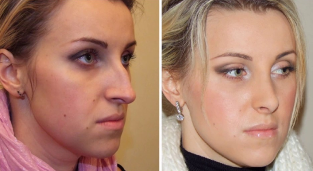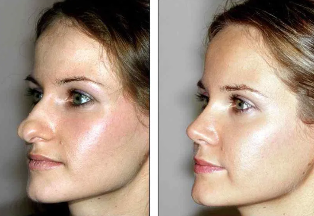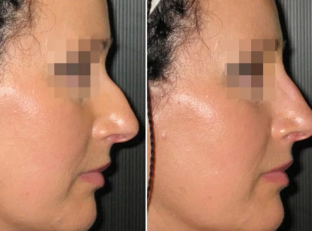Rhinoplasty is one of the most popular plastic surgery, which involves the manipulation in the area of the nose. The objective of this procedure – the restoration of the good shape of the nose, which was broken due to the injuries, diseases or pathologies congenital.
The history of the development of

You may think that rhinoplasty is a recent invention, and has used the services of surgeons with some stars and the model. This is not the case. The first mention of the technique of recovery of the nose relate to the ancient times. These operations have been carried out in India, over 1000 years before j.-c., the Indian doctors have restored damaged nose, taking the skin of the cheeks of the patient.
In Europe, the rhinoplasty was developed in the Middle ages. Italian surgeons have described his own method to re-create the shape of the nose of the skin of the face. In the 19th century, this type of operations has received a new development, thanks to the diligence of the English and German doctors. New methods based on the indian experience of the surgeons.
The original goal of the rhinoplasty was the repair of the nose, the cosmetic and the aesthetic factors of the acquis to the end of the 20th century.
Medical rhinoplasty
Any plastic surgery can be called a creative process, and rhinoplasty is no exception. It integrates an aesthetic solution of the problems with the restoration or the maintenance of the functions of the authority (the normal nasal breathing).
Therefore, it is a surgical procedure can continue as for therapeutic and aesthetic of the goal. The best is to do an operation at the age of 25-30 years, when the cartilage is fully formed. Of course, the recommended age may vary depending on the circumstances.
Medical:
- The violation of nasal breathing, or the whole of his absence.
- Traumatic injuries, have led to changes and the deformation of the cartilage and the bone.
- Physiological and offsetting a deviation of the septum.
- Innate curvature or deformation of the nasal septum.
- Cysts and polyps in the nose.
- Hypertrophy of the turbinates.
Violation anatomical structure of the nose lead to different functional complications and disease states. He may be a otitis, rhinosinusitis, bronchial asthma, snoring, frequent respiratory problems, atrophy or hypertrophy of the hull from the nose, difficulty of the nasal breathing.
It is particularly dangerous to the violation of nasal breathing for children. It may result in deprivation of oxygen to the brain, which leads to a mental and physical delay in development. The operations of recovery of the respiratory function can be assigned to up to 18 years.
Cosmetic indications for rhinoplasty
More than half of the operations change the shape of the nose are performed for aesthetic reasons. Patients who are seeking to achieve harmony in their appearance. The aesthetic indications for the realization of plastic surgery can be divided into two sub-groups:
- Objective. When the nose is disproportionate to the size, the shape.
- Subjective. This sub-set are, first of all, the psychological causes related to the evaluation of their appearance. For example, the patient does not like the small bump or rolled up.
The psychological causes are often related to a professional or social environment. The patient appear complex acute dissatisfaction of his appearance.
Aesthetic indications:
- A deviation of the nasal septum.
- Acquired and congenital malformations.
- Disproportionate dimensions compared to the face, the nose seems too large or too small.
- The saddle shape of the nose.
- Bump.
- Too wide nostrils.
- Little attractive shape when the tip of the nose, forked, falling, optimistic, thickened or sharp.
- Asymmetrical on the nose.
- Fix the consequences of a failed rhinoplasty.
It is important to understand that the result of the operation is not always possible to get a perfect result. In surgery, there are restrictions, therefore, the rhinoplasty has to be considered as a correction of an existing form.
Contraindications

Before the intervention many patients it is advised to consult a psychologist. There are cases where the patient has a normal shape of nose without cosmetic or functional. Then the problem will be resolved after working with a psychologist.
A ben the ado plastic can produce menus for the measures, and to say with accuracy if defects. There are certain parameters, which are estimated as the shape of the nose, and the harmony of its provisions on the forehead, the eyes, the mouth, the chin, the ears. On the advice of the doctor, you can simulate on a computer alleged the appearance after the operation.
Contra-indications:
- The age limits. The operation is not recommended to spend up to 18 and after the age of 40. These restrictions may be lifted for objective reasons.
- Diabetes mellitus, diseases of the kidneys, the liver, the cardio-vascular system.
- Folliculitis and acne in the area of the nose.
- Disorders of coagulation.
- Oncology.
- Mental illness.
- Period of menstruation.
Types of rhinoplasty
According to the objectives and the implementation of the interventions of the rhinoplasty is divided into several types.
The goal of the rhinoplasty may be:
- Reconstructive. It is the recovery of the violations that have arisen due to diseases, injuries, and defects of gestation.
- Of the aesthetic. It is the correction of cosmetic defects.
During an operation can be performed:
- An increase or a decrease in the nose.
- The winding-up of the kicker.
- The correction of the saddle shapes of nose, it is the elimination of the deepening.
- The correction of the shape of the tip of the nose.
- Septoplastike (it is the correction of the nasal septum).
- Post-traumatic reconstruction.
A method for accessing a surgical intervention can be opened and closed. A private method applies to operations esthtiques, because it is less traumatic. In this case, all incisions are made inside the nasal cavity. The skin detaches from the cartilage and the ben the ado can easily adjust the shape, working with the bones and the cartilage of cloth to remove the surplus or intensify with the help of implants. After the manipulation of the cups carefully are lined.
Open rhinoplasty is used in more complex cases, to correct the major changes and to achieve larger by the size of the operations. The incision is done on a skin fold between the wings of the nose. In this case, the ben the ado receives good access to the tissues, cartilage and bone. The healing of this method occurs over a long time, remains visible post-operative scarring.
Non-surgical rhinoplasty
Non-surgical rhinoplasty is not an alternative to the surgical intervention. However, there are methods to correct small defects.
Rhinoplasty with the help of the detectives (special cosmetic gels) will help to correct small imperfections, smooth out sharp angles, restoring symmetry, the shape of the tip. The application of the load allows you to hide a small bump, clean up the report of the hollow, round the tip.
The recovery period after such intervention is easier, the price of the procedure is low compared to the full operation. However, the effect of the load continues on a few months only (maximum 1.5 years). In some cases, at the site of injection to form fibrous tissue, and the effect of the procedure is retained for the years to come. But the more often a new procedure. There is a risk of complications: migration, which entered the gel and modification of the tissue structure over the course of multiple injections.
With the help of the injection, you can not only build, but also clean the tissues. There are medications on acne hormonal base, which can eliminate the bumps, bumps, and even in some cases, the kicker. During the introduction of these medicines is very important to be careful. Often, the procedure consists of several steps. At the end of 2-3 weeks will be visible in the result.
With the help of wires, you can adjust the shape of the wings of the nose, and even tighten the tip. Installed wires through the holes that can form scars. The wires may break due to the mobility of the nose. For these reasons, surgeons have little recourse to such a procedure.

The preparation of the operation
To be successful in this operation, it is necessary the interaction of patient and physician. Before the intervention of consultations have taken place, where the ben the with ado, you should explain to the patient that it will be to achieve a result.
Organises general study: analysis of blood, research of its of the coagulation, urine analysis, ELECTROCARDIOGRAM, analysis on HIV, hepatitis, syphilis.
Where appropriate, studies are carried out, the picture is taken. If you have a chronic illness, need to consult a therapist or a profile of specialist. The intervention will be postponed in case of aggravation of a chronic disease, the onset of acute respiratory diseases or lesions infectious of the skin. Before the operation will be an interview with the anaesthetist.
A doctor will recommend that you give up alcohol, smoking, to exclude from the junk food, cease taking of hypnotics and sedatives. Two weeks before surgery, you need to stop taking aspirin and its forpercent.
Complications
Rhinoplasty is one of the most complex of plastic surgery, as important and aesthetics, and the functional aspect. Complications can occur, depending on various factors of 4 to 15% of patients. They can be divided into systems and post-operative.
The exploitation of the complications:
- bleeding;
- breaks in the skin;
- the violation of the integrity or of diseases of the bones;
- avulsion cartilaginous flap, etc
Postoperative complications:
- the loss of sense of smell;
- the loss or decrease of the sensitivity of the nose and the lower lip;
- the difficulty of the nasal breathing;
- atrophic rhinitis;
- the deterioration of the cosmetics correct a lack or an absence of change;
- of psychological complications (the patient does not accept the changes in the appearance, he did not like the new face);
- the swelling of the nose and eyelids, inflammation, suppuration;
- the pigmentation of the skin, formation of scars, capillary of the grid;
- frequent or long nosebleeds;
- necrosis.
The most dangerous thing is a complication that may occur in the course of the rhinoplasty is an allergic reaction to the anesthesia. Anaphylactic shock can cause death in 20% of cases.
The recovery period
The patient can leave the hospital a few hours after the surgery or stay overnight for observation. The main recovery after the correction of the nose lasts for 3 weeks. A full restoration will come only in six months or a year.
The seams and plaster Longuet will be lifted by 1.5 week. Yet 2 weeks will not be possible to take a hot bath, wash them with warm water – this can cause bleeding, bruising, swelling of the face and neck. Sleeping on your back lying. You can't bend, lift weights. In dusty environments need to wear a mask.
In a period of three months, it must carefully be wary of the shots and the pressure on the nose, you can't wear goggles, masks, hats heavy. It is forbidden to access to the swimming pool and sun-bathing. The ben the ado may install other restrictions dictated individual state of the patient.
The results of the operation
The healing of cartilage and bone lasts for several months. The final result, the ben the ado and the patient can be estimated at around 8 months. The solution is to do a rhinoplasty (especially if is really explicit rmd) may be perceived by others as negative, therefore, the patient should be ready to the ambiguity of the reaction from family and friends.
The parents may be dissatisfied with the loss of family or ethnic devil. However, often the patient and his relatives, we do not see much effect of the operation, as swelling can mask changes, and they appear gradually.
Rhinoplasty is capable of quite strongly change appearance, but not worth it to believe that, with the help of plastic surgery can be without limits of shape all represented in the fantasies. The whole operation is a dangerous thing, can lead to complications and even to the deterioration of the stain. In order to deal with such an intervention should be seriously carefully weigh the potential benefits and the risks of negative effects.





















